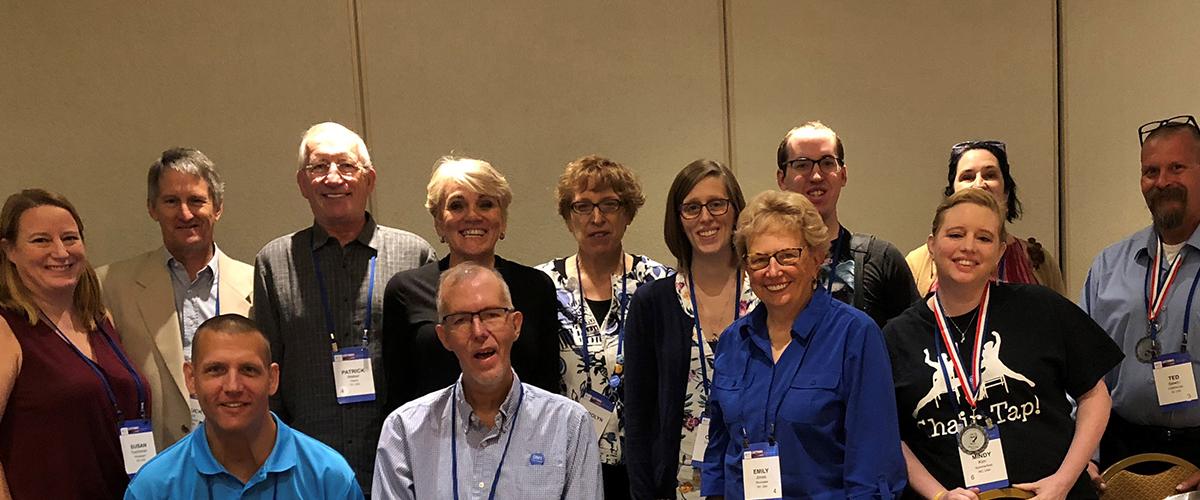ROSEVILLE, CA (January 25, 2012): MDF is pleased to announce its largest-ever round of Fund-A-Fellow postdoctoral fellowship research grant awards. In January 2012, MDF awarded four-$100,000 awards to postdoctoral Fellows working in universities and research facilities to encourage basic research in the management, treatment and cure of myotonic dystrophy (DM). This award cycle nearly doubles the number of fellowship grants awarded since the program was launched in 2009, and brings the total research funding awarded by the MDF to over $1M since its founding in 2006.
MDF will supoprt four new postdoctoral fellows in the 2012-2013 grant cycle for a total of $400,000. “Our goal in establishing this postdoctoral fellowship program was to attract and support researchers in the beginning stages of their careers, seeding research that could lead to larger grants from other entities such as the National Institutes of Health (NIH), the Centers for Disease Control and Prevention (CDC), the Muscular Dystrophy Association (MDA) and other governmental and philanthropic agencies. I believe that the ever increasing interest in the number of applications for this round of fellowships confirms that we are achieving our goal,” said Lisa Harvey, Education and Research Director for MDF.
Each recipient will receive $50,000 a year for two years. Applications were reviewed by a panel of distinguished international researchers and clinicians in the field of myotonic dystrophy. Final selections were determined by the MDF Board of Directors.
The four $100,000 postdoctoral fellowship grants have been awarded to Dr. Micah Bodner, Ph.D., at University of Oregon; Dr. Nicholas Johnson, M.D., at University of Rochester Medical Center; Dr. Zhihua (Tina) Gao, Ph.D., at Baylor College of Medicine; and Dr. Eric Wang, Ph.D., at Harvard-MIT Division of Health Sciences and Technology (HST).
Research Information
Micah Bodner, Ph.D.
Dr. Bodner’s research, “Therapeutic Agents for Myotonic Dystrophy; Defining the Pharmacophore of Pentamidine,” under the guidance of Dr. John Andrew Berglund, Ph.D. and Dr. Michael Haley, Ph.D., at the University of Oregon, will continue the study of a potential therapeutic drug, pentamidine, which was recently identified by the University of Oregon. Pentamidine is a promising lead compound for treatment of DM. Pentamidine and compounds like it have been used to reverse symptoms of DM in cell and mouse models of the disease and even alleviate myotonia in mice. However, some obstacles must be overcome before a pentamidine-based compound can be used clinically. The obstacles include: a lack of evidence for how pentamidine elicits the therapeutic effect; lack of oral availability; lack of central nervous system (CNS) activity; and toxicity. The experiments proposed in Dr. Bodner’s research plan are designed to increase understanding of how pentamidine functions and how to manipulate it in order to make a useful DM therapeutic that is orally available, CNS active and non-toxic.
The information gained from these experiments will also be used to design other compounds similar to pentamidine to better understand what portions of the compound promote binding to the RNA fragment. These compounds will then be used in DM cell and mouse model testing to understand how they perform in tests and whether they are tolerated by the cells and animals.
Nicholas Johnson, M.D.
Dr. Johnson’s research, “Characterization of Symptoms and Development of a Disease Specific Instrument for Congenital and Juvenile Myotonic Dystrophy,” under the guidance of Dr. Chad Heatwole, M.D. at the University of Rochester Medical Center in Rochester, New York, will study the severe congenital and juvenile onset forms of myotonic dystrophy.
Currently, there is very little information about the most critical symptoms associated with these forms of the disease. There are anecdotal reports that indicate that the issues important to patients with early onset myotonic dystrophy are different from those experienced by adult onset myotonic dystrophy patients. To date no significant research has been conducted to study the impacts of promising adult-onset DM therapies in congenital and juvenile-onset populations. This project will collect survey data from children and their parents describing and prioritizing the effects of the disease on the children’s cognitive, physical, and emotional health. This data will be used to create instruments measuring quality of life for these populations. These instruments will address the most critical and prevalent issues to congenital and juvenile-onset DM patients and their family members and will be designed for use in the upcoming clinical trials.
Zhihua (Tina) Gao, Ph.D.
Dr. Gao’s research, “Development of Therapeutic Approaches to Silence CUG Expansion RNA in Myotonic Dystrophy Mouse Models Using Recombinant Adeno-associated Virus,” under the guidance of Dr. Thomas Cooper, M.D., at Baylor College of Medicine in Houston, Texas, will use a virus that has been modified for therapies of other muscular dystrophies to carry elements that can remove the toxic RNA in myotonic dystrophy mouse models. The effective therapeutic approach developed in the mouse model holds a potential for future clinical trials in DM1 patients.
Myotonic dystrophy is caused by an unusual genetic mutation in which a small DNA segment of the mutated gene is repeated hundreds of times. DNA, in the form of chromosomes, is in the nucleus of a cell. When there is a need, DNA is copied into RNA. RNA then moves from the nucleus to the cytoplasm of the cell to deliver the genetic message. In myotonic dystrophy, the mutated gene is copied into RNA, but the RNA is trapped in the nucleus because of the repeated segments. The RNA then builds up in the nucleus and creates problems that disrupt the functions of many other genes. The RNA with repeated segments therefore becomes very toxic.
By forcing the expression of the mutated gene with hundreds of repeated segments in mouse skeletal muscle and heart, researchers have mimicked the DM1 (type 1) disease in mice. The goal of Dr. Gao’s proposal is to develop a recombinant adeno-associated virus (rAAV) vector-based strategy to clear away the toxic RNA in the DM1 mice. Dr. Gao’s sponsoring facility, the lab of Dr. Thomas Cooper, M.D., at Baylor College of Medicine, recently established a collaboration with Dr. Reed Clark, Ph.D., at the Center for Gene Therapy at Nationwide Children's Hospital/Ohio State University in Columbus, Ohio, led by Dr. Jerry R. Mendell, M.D. A major effort of the Center is to develop rAAV vectors for therapeutic approaches for DMD, LGMD, FSHD, and DM1. Once established and optimized in mice, Dr. Gao and her team will work with collaborators to develop rAAV as a therapeutic approach for human trials. This strategy will be developed for DM1, the more common form of DM, but can also be used for DM2 (type 2).
Eric Wang, Ph.D.
Dr. Wang’s research, “Identification of RNA Processing Changes in the Myotonic Dystrophy Transcriptome,” under the guidance of Dr. Christopher Burge, Ph.D., and Dr. David E. Housman, Ph.D., at Harvard-MIT Division of Health Sciences and Technology (HST), Cambridge, Massachusetts, will help to improve the understanding of DM pathogenesis.
Various events associated with the expanded RNA repeat sequences that cause DM have been well established, but there are other hypotheses for what happens during DM pathogenesis. To date there have been no studies globally surveying all the RNA changes in DM, making it challenging for the DM research community to conclude whether it has identified all the major cellular pathways disturbed in DM. Identifying all these changes will provide a research road map, as well as specific readouts that can be used for diagnostics and therapeutic studies. Using a type of high throughput sequencing technology that has been recently developed, Dr. Wang proposes to identify RNA level changes that occur in various mouse models of DM, assess the extent to which current models for DM pathogenesis can explain what is happening in human DM, and develop potential therapeutic interventions using the insights gained from these analyses. The successful completion of these studies will augment the DM community’s understanding of DM pathogenesis, and provide a set of biomarkers that can be used immediately for diagnostics and therapeutic development.
View our past grant recipients
About Myotonic Dystrophy
Described as “the most variable of all diseases found in medicine”, myotonic dystrophy is an inherited disorder that can appear at any age and that manifests differently in each individual. Considered by some researchers to be the most common form of muscular dystrophy, DM affects approximately 1:8,000 people worldwide and can cause not only muscle weakness, atrophy and myotonia (the delayed relaxation of a muscle), but also problems in the heart, brain, GI tract, endocrine, skeletal and respiratory systems. The variability of this disease often makes it difficult to diagnose. Since the gene was identified in the early 1990’s, researchers have discovered that the genetic flaw generally enlarges and causes more severe symptoms in subsequent generations, rendering it a genetic time bomb.
About MDF
MDF is a patient advocacy organization dedicated to leading and mobilizing resources toward effective management, treatment and ultimately a cure for myotonic dystrophy. The Foundation provides invaluable medical information, empowering families and medical providers as they navigate the disease process. The website, www.myotonic.org, and medical information provided by the Foundation, is approved by members of the MDF Scientific Advisory Committee, comprised of experts in the field of myotonic dystrophy and muscle research who together have devoted more than ninety years to the research and treatment of myotonic dystrophy. In addition, MDF has a community website where families and caregivers meet others living with similar challenges and share information.
Questions?
For more information about MDF , contact us at info@myotonic.org or 86-MYOTONIC.
05/16/2012

